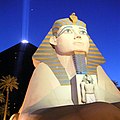Egyptian Revival architecture

Egyptian Revival is (primarily) an architectural style (part of eclecticism) that makes reference to motifs and imagery of Ancient Egypt, offering some concrete examples of the evolving picture of Egypt in the European imagination. Partly because its association with the death cult of ancient Egypt and partly because, unlike the Greek Revival, its moral and political associations were not of progressive enlightenment or a "cradle" equally readable as of aristocratic literary culture or of democracy", the "Egyptian taste" has never been enormously popular; nevertheless, it has left its mark in Europe and North America.
First wave
There were several waves of the revival. The first wave of Egyptomanie in France was inspired by Napoleon's expedition to Egypt, memorialized in the first volumes of Description de l'Egypte (1809). The French taste was mainly limited to furniture and decorative objects, but in London, purely archaeological interest, stripped of imperial enthusiasms resulted in the Egyptian Hall in London, completed in 1812, and the Egyptian Gallery devised by the connoisseur Thomas Hope to display his Egyptian antiquities, and illustrated in engravings from his meticulous line drawings in his Household Furniture (1807), a prime source for the Regency style in British furnishings. With the opening of the cemetery at Highgate, with its Egyptian Avenue, the Egyptian manner developed a special popularity as particularly appropriate in mortuary contexts, as with cemetery gates.
In Russia, this wave — associated primarily with the discoveries of Champollion — produced similar monuments:
- Egyptian Bridge
- Quay (1832-1834) designed by Konstantin Thon in front of the Imperial Academy of Arts building
- Egyptian Gate
- The Regional Studies Museum in Krasnoyarsk
Second wave
A second wave of popularity developed in the 1840s and 1850s. From this period, only a few buildings are known to survive in the United States:
- the 1845 massive brownstone entry gates of the Grove Street Cemetery at Yale by architect Henry Austin.
- the 1851 Downtown Presbyterian Church in Nashville, Tennessee by architect William Strickland (who also did the Tennessee statehouse).
- the 1856 Skull & Bones undergraduate secret society at Yale. Architect's attribution in dispute, but may also be Henry Austin of the Grove Street Cemetery Gates.
- the old Dubuque County, Iowa jail, designed by architect John Francis Rague, and completed in 1859. It is now a historical museum[1]. Rague is better known as architect of the old Iowa statehouse in Iowa City, Iowa.
- the Egyptian Building of the Medical College of Virginia[2]

Third wave
The expeditions that eventually led to the discovery in 1922 of the treasure of Tutankhamun's tomb by the archaeologist Howard Carter led to a third revival. Grauman's Egyptian Theatre in Los Angeles, USA, now home to the American Cinematheque, is an Egyptian Revival theatre from the era. Interestingly, the Egyptian Theatre was designed, built and opened in October 1922, two weeks before the historic discovery in November 1922 of the tomb.
The Reebie Storage Warehouse in Chicago, Illinois features twin statues of Ramses II and accurate use of ancient Egyptian images and hieroglyphics. Plaster reliefs depict ancient Egyptians moving grain on barges. The warehouse is one of the nation's best examples of pure academic-style Egyptian Revival commercial architecture, and is designated as a Chicago Landmark and listed on the National Register of Historic Places.
Simultaneously, Aleksey Shchusev designed Lenin's Mausoleum with many elements borrowed from the Pyramid of Djoser. The Egyptian revival of the 1920s is sometimes considered to be part of the Art Deco decorative arts movement. It was present in furniture and other household objects, as well as in architecture.
The Louvre Pyramid in Paris and Rosicrucian Egyptian Museum in San Jose, California are modern-day examples of Egyptian Revival structures. Additionally, Rosicrucian Park contains many examples of Egyptian Revival architecture.
Images
-
Medical College of Virginia, 1845
-
MCV detail
-
MCV detail
-
Courthouse, Independence, Missouri, ca 1852
-
First Presbyterian Church, William Strickland, Nashville, TN, 1951
-
1st Pres. Ch. detail
-
Egyptian Theater, DeKalb, Illinois
-
DeKalb
-
Dekalb
-
Scottish Rite Temple in Mobile, Alabama, built 1921.
Late 20th Century
-
The Pyramid Arena in Memphis, Tennessee
-
The Luxor Hotel in Las Vegas, Nevada
Egyptian influenced funerary architecture
-
Dodge Brothers Mausoleum, Detroit
-
mausoleum of Maj. A.B. Watson, Oakhill Cemetery, Grand Rapids, Michigan
-
(where?) Philadelphia
-
(where?) Philadelphia
-
Cemetery, Milwaukee, Wisconsin

















